Chores, Chores, And More Chores
Dec 26, 2024 by Tempe Javitz
CHORES, CHORES, AND MORE CHORES!
If you are a mother and a rancher’s wife there’s not a moment
free, except when you lay your head on your pillow. For my
grandmother Jessamine, Mondays were reserved for washing. It
took most of the day to do the wash for her family of nine and
the hired help. Tuesdays were dedicated to ironing. Sometimes
Jessamine would hire a local girl to help with the endless ironing
and sewing. Most of the garments that her children wore were
homemade. Yes, homemade clothes. Who had time for sewing for
seven children and herself? It boggles the mind. No running to
K-Mart or Wallmart.
If washing, ironing, making clothing for the children, and riding
out to help the men wasn’t enough, Jessamine had her hands full
keeping a cook employed to make the household run smoothly. As
all ranch housewives will attest, hiring and keeping a cook on a
remote ranch some forty miles from the nearest town is a tricky
proposition. Jessa’s diaries are peppered with many stories of
the woes of hiring and keeping help of any kind, especially a cook.
It also appears that cooks were often hired in haste and regretted
at leisure.
In June the usual summer activities commenced: planting a huge
garden, picking chokecherries, plums, and service berries to can,
visiting the Spear roundup on Tullock Creek and bringing lunch for
all the cowboys. By August, Jessamine proudly exclaims in her diary
“I have twenty-nine gallons of service berries canned and put away
in the cellar.” But what about the wild plums and chokecherries
that are ripe now?
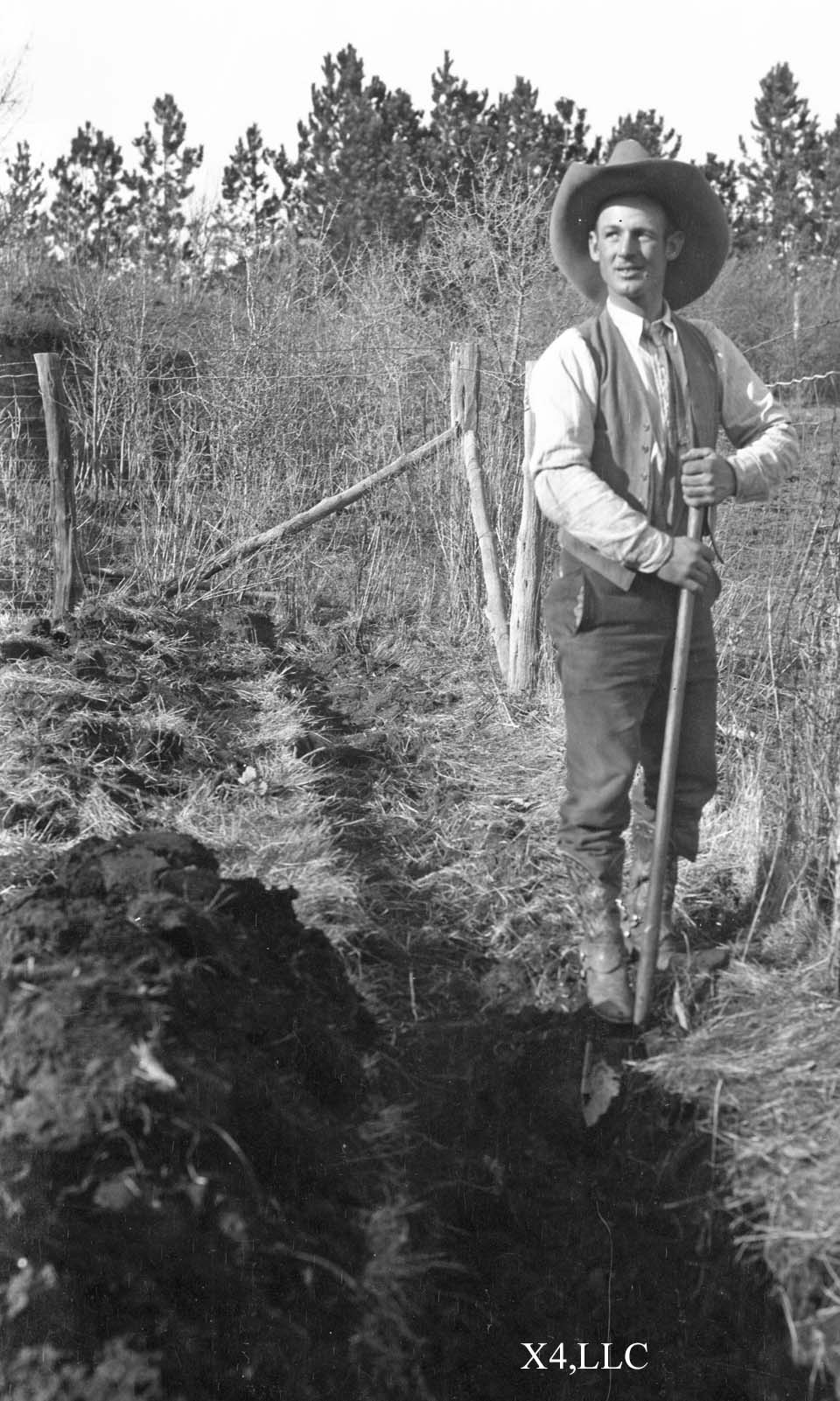
Dave Whaley digging in the garden, March 1930
How about the cowboys and hired hands? In the mid to late 1920’s
the Reservation Pool roundup had four working wagons. The Antler
ranch had one wagon, and Willis Spear, Junior Spear, and Will
Johnson had the other three. Each wagon had approximately one
hundred and twenty-five horses. Each wagon was usually accompanied
by ten cowboys, with ten horses per man. There were two horse
wranglers, one for daytime and one for the night, plus the cook.
A horse wrangler also chopped wood and hauled water. Four horses
pulled the bed wagon and four pulled the mess or chuck wagon.
Jessamine showed up with her camera to record it all. You can
imagine the chores. Each and every cowboy had a daily round of
helping the cook, rounding up the horses, and then gathering the
cattle to brand the calves. When branding took place on open
range land, an area easy to hold cattle and set up a branding fire
was all that was necessary. There were usually one or two ropers,
several sets of wrestlers, two or three men branding, several who
did the ear marking, and one or two castrators. These roundups
included several different ranches gathering separating brands,
and branding together for a month or two on the large Crow and
Northern Cheyenne reservations. The reservations then were just
fenced on the perimeters. The ranch owners had to travel to
Washington, D.C. each year and arrange and pay for leasing rights.
The cattle were left to wander throughout the winter, and bad storms
took a heavy toll.
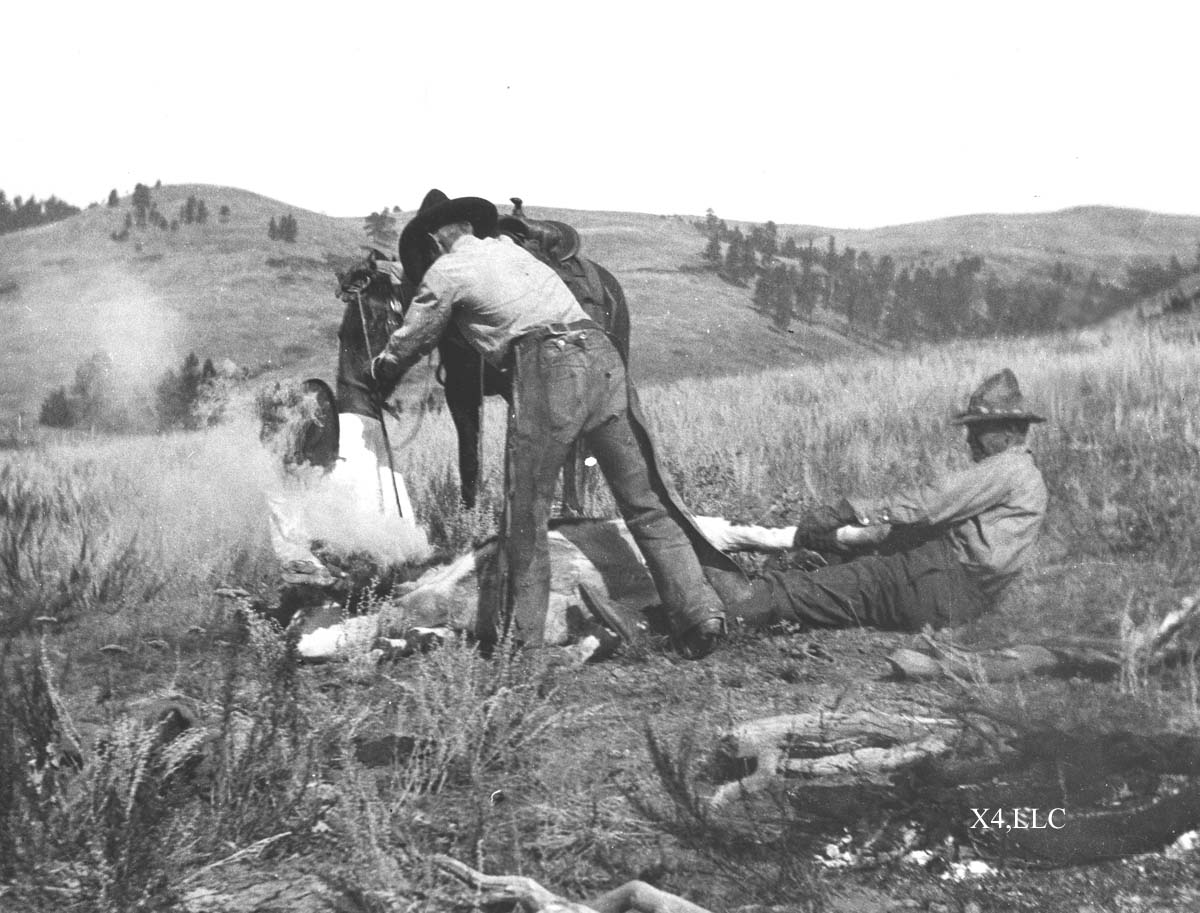
Branding on the open range, circa 1922.
The roundups in the open range only lasted until the late 1920s when
the Crow and Northern Cheyenne tribes divided up the range into
allotments for their tribal members. Ranch lands shrank to more
manageable acres, including bottom lands in the Wolf Mountains
where hay could be raised to keep the cattle through the long winters.
Indian families who did not live on their specific allotments, leased
their lands to local ranchers under a competitive bid allocation.
Now those busy cowboys had to learn to take care of fences, ride
the waterholes and springs (to make sure they were open and running),
learn how to drive the tractors, and then put up the hay. In the
early fall dehorning began followed by a gathering in October for
weaning the calves. Sometimes an extra roundup might occur in late
spring to sell the two or three-year old steers. All winter long
they spent a large part of each day loading the hay wagons and
feeding the cattle on the pastures near to the ranch headquarters.
Never a dull moment! Those “cowboys” were also kept busy cutting
the ice in the local reservoir each winter to fill the ice house
for the summer. “Chores” would also include breaking the ice in
the creeks so the horses and cattle had sufficient water. One or
two horses were always kept in the barn and used as needed. They
needed to be watered and fed each day.
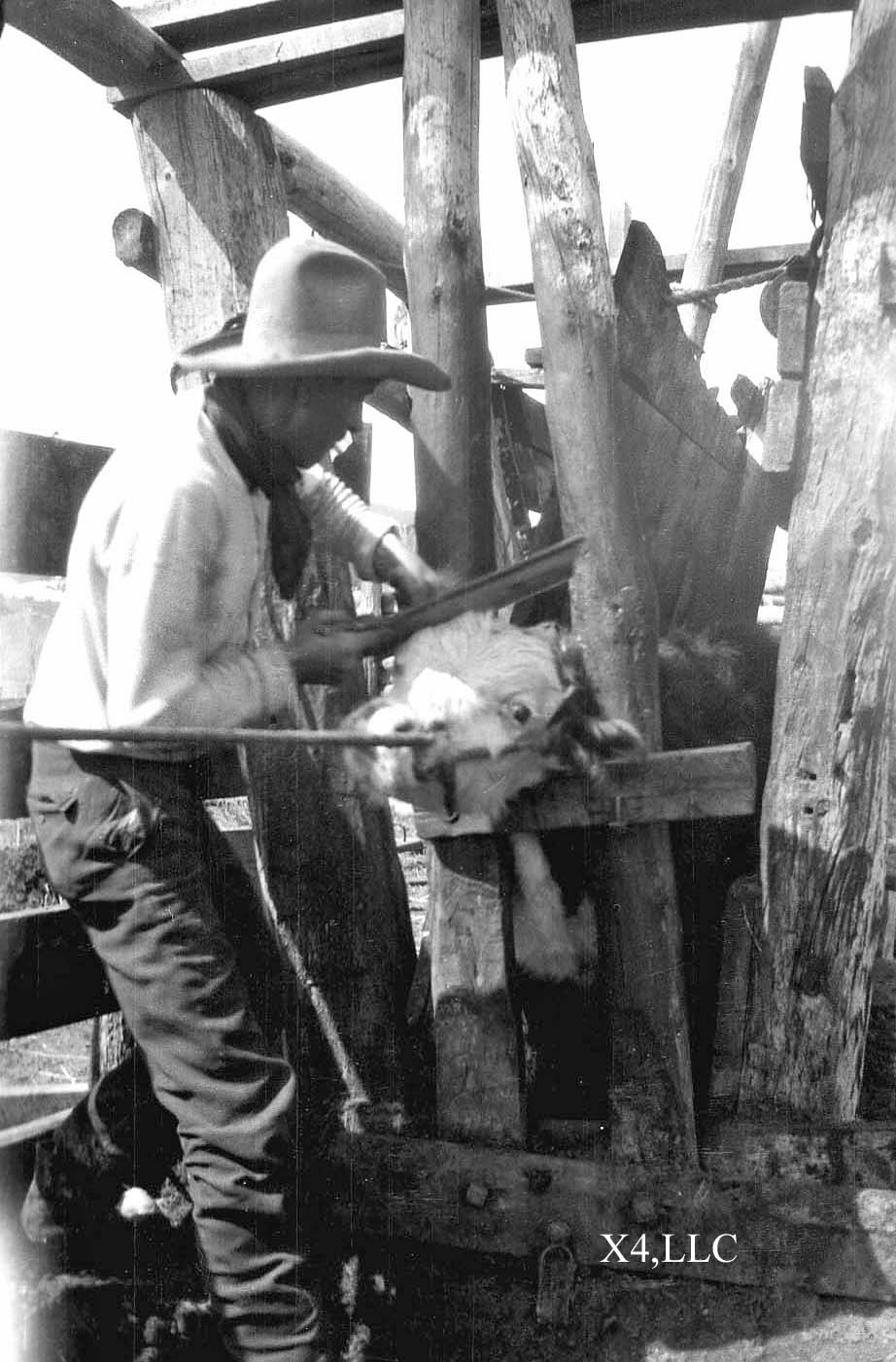
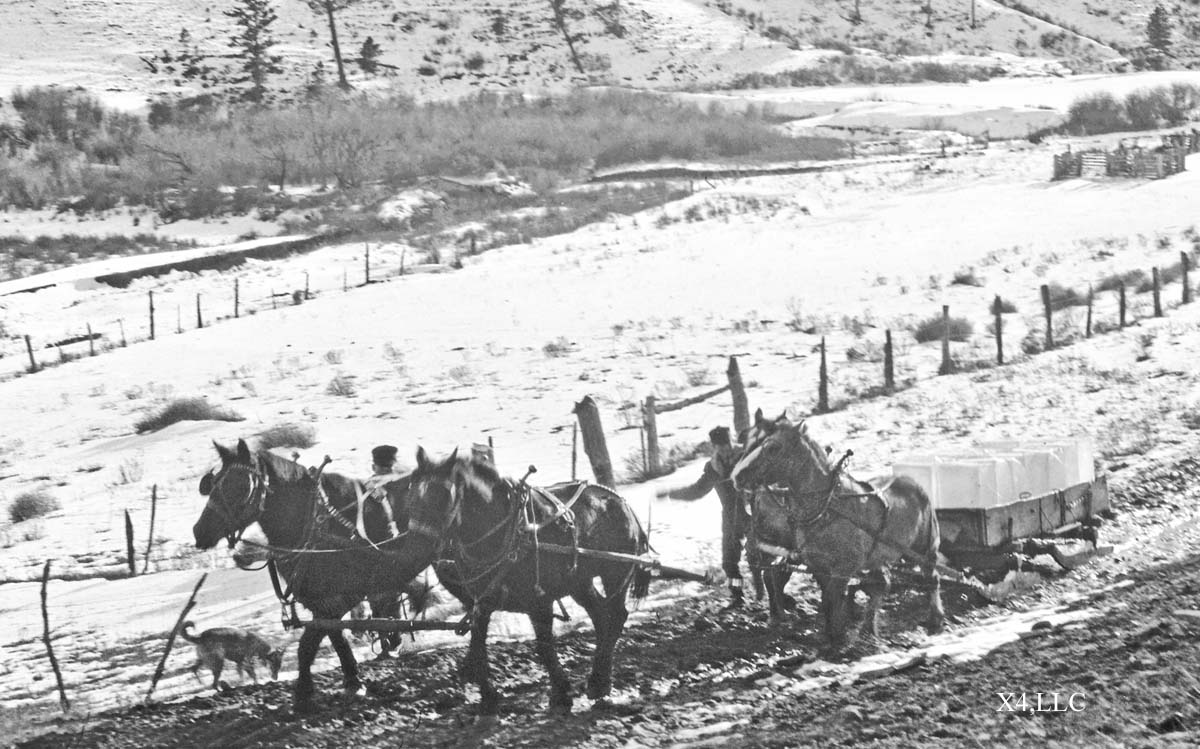
Dehorning at the X4 Ranch Hauling ice from local reservoir, circa 1922
Large ranches regularly kept chickens, turkeys, pigs, and a beef
steer being fattened up for slaughter. More animals to add to the
daily chore. Someone also had to collect the eggs and actually
kill the animals to eat. Note from Jessamine’s diary on Thursday,
January 12, 1922: “Will and the boys butchered 4 hogs today.”
Friday, January 13th: “Rendering lard today. Fried down all the
sausage and have a five-gallon jar and a two gallon can full of
fried sausage, besides saving out two gallons of fresh for Mama
and sister Elsie in town. My feet are dreadfully swollen and sore
tonight (she is 5 months pregnant).” Saturday, January 14th.
“Worked hard all day. Scrubbed the kitchen after we got through
rendering the lard.”
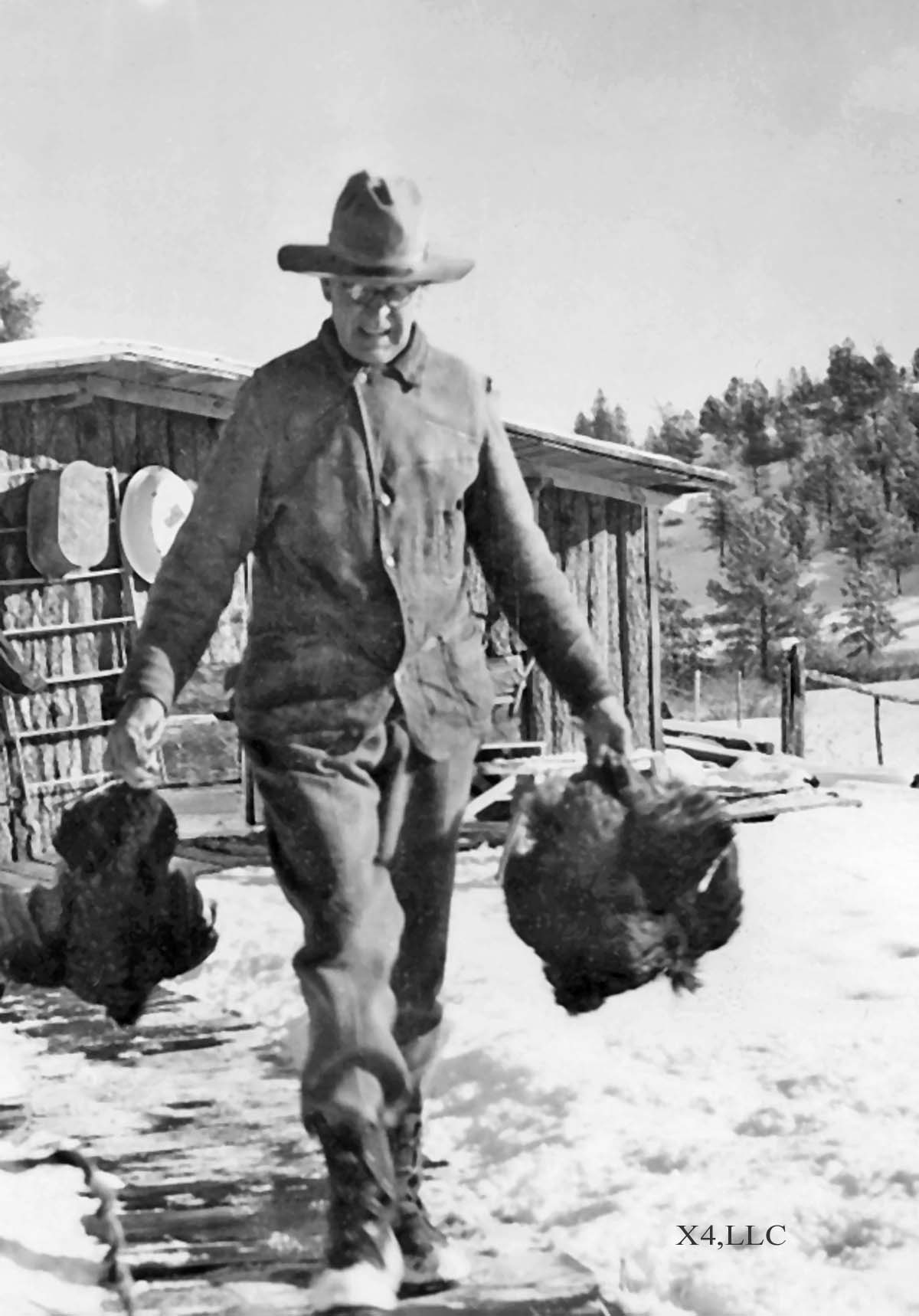
Will with chickens for Xmas dinner
Rosebud Mtn Ranch (1937)
Oh, I forgot to mention the sheep! Jessamine’s husband Will had
several bands of sheep. Most of them were grazing high in the Big
Horn Mountains each summer being taken care of by individual sheep
herders and their talented dogs. Will would often be gone for
several days at a time checking on the bands. Hence a ranch manager
living in one of the small outbuildings (often with a wife) was
essential for their headquarters ranch. In the winter, the sheep
bands were brought down to graze the hills near their X4 Ranch in
Kirby, Montana (1919 through 1933). The herders and dogs had to be
supplied with fresh water and food, another chore for the core group
of workers at the ranch.
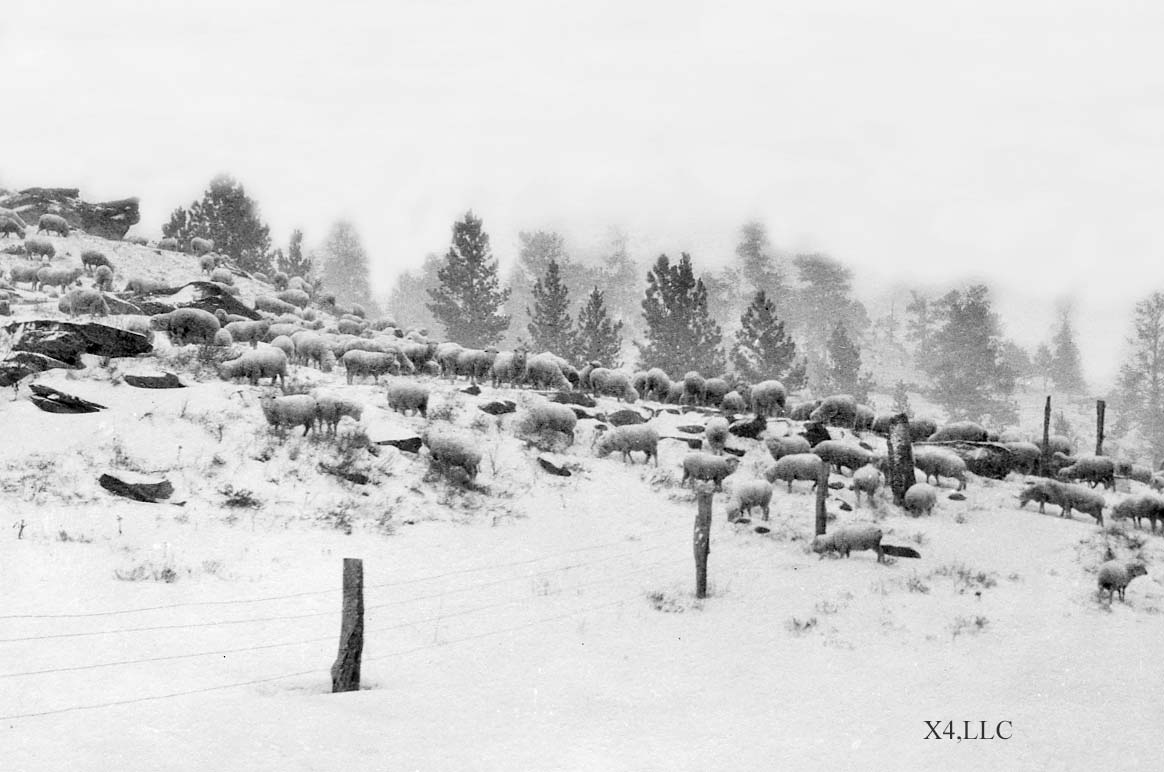
Sheep grazing, winter time X4 Ranch, circa 1929
I think you get the picture. Running a ranch is lots of work, never
dull, and sometimes dangerous. I’m the daughter of Jessamine’s 5th
child, Torrey Johnson. Torrey and wife Adrienne bought the ranch
adjacent to Jessamine’s brother Junior Spear on Corral Creek near
the Rosebud Creek in Montana. Jessamine and Will’s X4 Ranch was
about 15 miles south towards the Wyoming border. I grew up doing
lots of the chores described above. You may not be surprised that
I told my mother at about age 13, “I’m so out of here!” I could
see that the work load was large and the pay terrible. I also
refused to learn how to milk the milk cow, and often had regular
fights with the roosters in the chicken yard.
While you are waiting for more tales about Jessamine and her family,
I invite you to read my prior blogs or my book. Thank you for your
continued interest !!! Happy Holidays to you and your families.
Here’s the link for my book on my web page. The link is at the top
of the page: https://tempejavitz.com/
If you are a mother and a rancher’s wife there’s not a moment
free, except when you lay your head on your pillow. For my
grandmother Jessamine, Mondays were reserved for washing. It
took most of the day to do the wash for her family of nine and
the hired help. Tuesdays were dedicated to ironing. Sometimes
Jessamine would hire a local girl to help with the endless ironing
and sewing. Most of the garments that her children wore were
homemade. Yes, homemade clothes. Who had time for sewing for
seven children and herself? It boggles the mind. No running to
K-Mart or Wallmart.
If washing, ironing, making clothing for the children, and riding
out to help the men wasn’t enough, Jessamine had her hands full
keeping a cook employed to make the household run smoothly. As
all ranch housewives will attest, hiring and keeping a cook on a
remote ranch some forty miles from the nearest town is a tricky
proposition. Jessa’s diaries are peppered with many stories of
the woes of hiring and keeping help of any kind, especially a cook.
It also appears that cooks were often hired in haste and regretted
at leisure.
In June the usual summer activities commenced: planting a huge
garden, picking chokecherries, plums, and service berries to can,
visiting the Spear roundup on Tullock Creek and bringing lunch for
all the cowboys. By August, Jessamine proudly exclaims in her diary
“I have twenty-nine gallons of service berries canned and put away
in the cellar.” But what about the wild plums and chokecherries
that are ripe now?

Dave Whaley digging in the garden, March 1930
How about the cowboys and hired hands? In the mid to late 1920’s
the Reservation Pool roundup had four working wagons. The Antler
ranch had one wagon, and Willis Spear, Junior Spear, and Will
Johnson had the other three. Each wagon had approximately one
hundred and twenty-five horses. Each wagon was usually accompanied
by ten cowboys, with ten horses per man. There were two horse
wranglers, one for daytime and one for the night, plus the cook.
A horse wrangler also chopped wood and hauled water. Four horses
pulled the bed wagon and four pulled the mess or chuck wagon.
Jessamine showed up with her camera to record it all. You can
imagine the chores. Each and every cowboy had a daily round of
helping the cook, rounding up the horses, and then gathering the
cattle to brand the calves. When branding took place on open
range land, an area easy to hold cattle and set up a branding fire
was all that was necessary. There were usually one or two ropers,
several sets of wrestlers, two or three men branding, several who
did the ear marking, and one or two castrators. These roundups
included several different ranches gathering separating brands,
and branding together for a month or two on the large Crow and
Northern Cheyenne reservations. The reservations then were just
fenced on the perimeters. The ranch owners had to travel to
Washington, D.C. each year and arrange and pay for leasing rights.
The cattle were left to wander throughout the winter, and bad storms
took a heavy toll.

Branding on the open range, circa 1922.
The roundups in the open range only lasted until the late 1920s when
the Crow and Northern Cheyenne tribes divided up the range into
allotments for their tribal members. Ranch lands shrank to more
manageable acres, including bottom lands in the Wolf Mountains
where hay could be raised to keep the cattle through the long winters.
Indian families who did not live on their specific allotments, leased
their lands to local ranchers under a competitive bid allocation.
Now those busy cowboys had to learn to take care of fences, ride
the waterholes and springs (to make sure they were open and running),
learn how to drive the tractors, and then put up the hay. In the
early fall dehorning began followed by a gathering in October for
weaning the calves. Sometimes an extra roundup might occur in late
spring to sell the two or three-year old steers. All winter long
they spent a large part of each day loading the hay wagons and
feeding the cattle on the pastures near to the ranch headquarters.
Never a dull moment! Those “cowboys” were also kept busy cutting
the ice in the local reservoir each winter to fill the ice house
for the summer. “Chores” would also include breaking the ice in
the creeks so the horses and cattle had sufficient water. One or
two horses were always kept in the barn and used as needed. They
needed to be watered and fed each day.


Dehorning at the X4 Ranch Hauling ice from local reservoir, circa 1922
Large ranches regularly kept chickens, turkeys, pigs, and a beef
steer being fattened up for slaughter. More animals to add to the
daily chore. Someone also had to collect the eggs and actually
kill the animals to eat. Note from Jessamine’s diary on Thursday,
January 12, 1922: “Will and the boys butchered 4 hogs today.”
Friday, January 13th: “Rendering lard today. Fried down all the
sausage and have a five-gallon jar and a two gallon can full of
fried sausage, besides saving out two gallons of fresh for Mama
and sister Elsie in town. My feet are dreadfully swollen and sore
tonight (she is 5 months pregnant).” Saturday, January 14th.
“Worked hard all day. Scrubbed the kitchen after we got through
rendering the lard.”

Will with chickens for Xmas dinner
Rosebud Mtn Ranch (1937)
Oh, I forgot to mention the sheep! Jessamine’s husband Will had
several bands of sheep. Most of them were grazing high in the Big
Horn Mountains each summer being taken care of by individual sheep
herders and their talented dogs. Will would often be gone for
several days at a time checking on the bands. Hence a ranch manager
living in one of the small outbuildings (often with a wife) was
essential for their headquarters ranch. In the winter, the sheep
bands were brought down to graze the hills near their X4 Ranch in
Kirby, Montana (1919 through 1933). The herders and dogs had to be
supplied with fresh water and food, another chore for the core group
of workers at the ranch.

Sheep grazing, winter time X4 Ranch, circa 1929
I think you get the picture. Running a ranch is lots of work, never
dull, and sometimes dangerous. I’m the daughter of Jessamine’s 5th
child, Torrey Johnson. Torrey and wife Adrienne bought the ranch
adjacent to Jessamine’s brother Junior Spear on Corral Creek near
the Rosebud Creek in Montana. Jessamine and Will’s X4 Ranch was
about 15 miles south towards the Wyoming border. I grew up doing
lots of the chores described above. You may not be surprised that
I told my mother at about age 13, “I’m so out of here!” I could
see that the work load was large and the pay terrible. I also
refused to learn how to milk the milk cow, and often had regular
fights with the roosters in the chicken yard.
While you are waiting for more tales about Jessamine and her family,
I invite you to read my prior blogs or my book. Thank you for your
continued interest !!! Happy Holidays to you and your families.
Here’s the link for my book on my web page. The link is at the top
of the page: https://tempejavitz.com/
